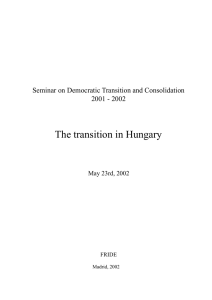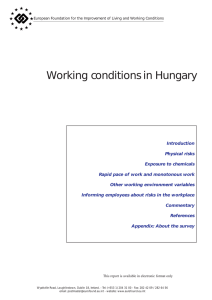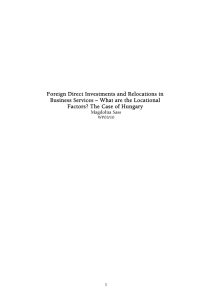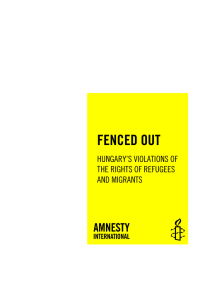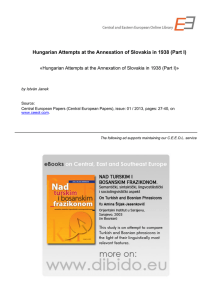Foreign language teaching in Primary Education in Hungary
Anuncio
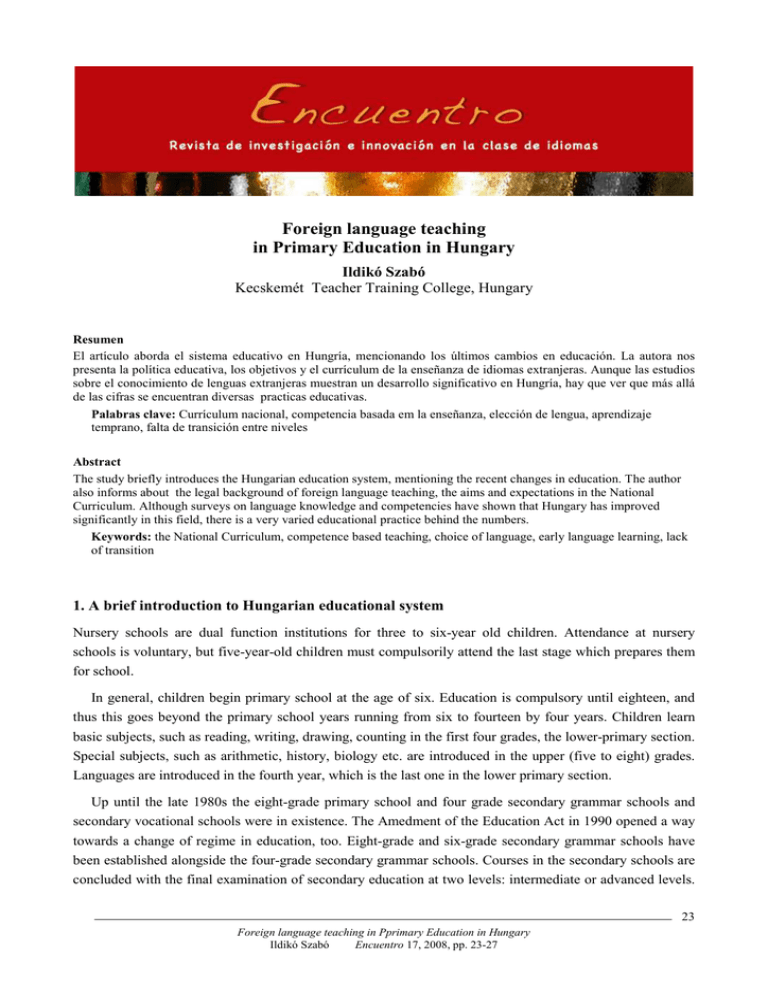
Foreign language teaching in Primary Education in Hungary Ildikó Szabó Kecskemét Teacher Training College, Hungary Resumen El artículo aborda el sistema educativo en Hungría, mencionando los últimos cambios en educación. La autora nos presenta la política educativa, los objetivos y el currículum de la enseñanza de idiomas extranjeras. Aunque las estudios sobre el conocimiento de lenguas extranjeras muestran un desarrollo significativo en Hungría, hay que ver que más allá de las cifras se encuentran diversas practicas educativas. Palabras clave: Currículum nacional, competencia basada em la enseñanza, elección de lengua, aprendizaje temprano, falta de transición entre niveles Abstract The study briefly introduces the Hungarian education system, mentioning the recent changes in education. The author also informs about the legal background of foreign language teaching, the aims and expectations in the National Curriculum. Although surveys on language knowledge and competencies have shown that Hungary has improved significantly in this field, there is a very varied educational practice behind the numbers. Keywords: the National Curriculum, competence based teaching, choice of language, early language learning, lack of transition 1. A brief introduction to Hungarian educational system Nursery schools are dual function institutions for three to six-year old children. Attendance at nursery schools is voluntary, but five-year-old children must compulsorily attend the last stage which prepares them for school. In general, children begin primary school at the age of six. Education is compulsory until eighteen, and thus this goes beyond the primary school years running from six to fourteen by four years. Children learn basic subjects, such as reading, writing, drawing, counting in the first four grades, the lower-primary section. Special subjects, such as arithmetic, history, biology etc. are introduced in the upper (five to eight) grades. Languages are introduced in the fourth year, which is the last one in the lower primary section. Up until the late 1980s the eight-grade primary school and four grade secondary grammar schools and secondary vocational schools were in existence. The Amedment of the Education Act in 1990 opened a way towards a change of regime in education, too. Eight-grade and six-grade secondary grammar schools have been established alongside the four-grade secondary grammar schools. Courses in the secondary schools are concluded with the final examination of secondary education at two levels: intermediate or advanced levels. 23 Foreign language teaching in Pprimary Education in Hungary Ildikó Szabó Encuentro 17, 2008, pp. 23-27 The level can be chosen by the student in each subject. Admission to higher education requires an advanced level final exam in the subjects that are defined by the chosen university. In higher education Bologna process has been introduced in 2003. It means that previous college and university courses have been replaced by BA and MA ones. 2. Foreign language teaching in the National Curriculum Amendment of the Education Act in 2007 defines the principles and aims of teaching modern foreign languages. Foreign language teaching is compulsorily introduced in the fourth grade and lasts till the end of compulsory education (it means students should learn at least one foreign language from the age of ten till the age of eigthteen). According to the law, foreign language teaching could be introduced earlier if the facilities are suitable. The law also emphasises that language learning in the first five years of education means a playful way of getting to know the language. The aims of teaching and learning foreign languages are to make our students educated, mobile citizens of Europe who are able to speak several foreign languages. The main aim is to provide them with a communicative competence which means useful language knowledge. It also means the capability of using the language in a suitable way in a given situation. This competence can be assessed through the basic skills (listening, speaking, reading and writing). Improving foreign language competence means that by the end of compulsory education students are able to use one or two foreign languages in private, educational, professional and civic contexts. Students are to acquire a positive attitude towards language learning, foreign languages and cultures. Language learning is a part of life-long learning programmes, therefore students are to be able to maintain, improve their language knowledge and learn other languages as well. The National Curriculum defines a minimal level that should be reached by the end of the main phases of compulsory education (6th, 8th and 12th grades). These levels correlate with the levels of the Common European Framework. According to the law, everybody is to reach B1 level by the end of the compulsory education. In the case of advanced foreign language teaching programmes, this minimum level is B2. Reaching master level (C1, C2) is not an expectation in compulsory education. Talking about the number of foreign language lessons in compulsory education, the National Curriculum sets percentages. In the lower primary classes (grades 1-4) 2-6%, in the upper primary (grades 5-8) 12-20% of the lessons should be foreign language ones weekly. Practically it means that students usually have 2 or 3 foreign language lessons per week. In 2007 the Hungarian Ministry of Education introduced a new aspect in the National Curriculum. According to it in the 5th grade in the primary schools (which is the first year in the upper primary section) students have to be taught with lower primary methods. Minimum 20 per cent of their numbers of lessons weekly should be devoted to develop their competencies using lower primary methods. Hungarian Literature and Grammar, Foreign Language, Mathematics are the subjects that are to be taught like this compulsorily in every school; schools can choose two more subjects in which they use these methods. Altogether 4.5 lessons weekly should be on developing competencies; the subject material cannot be taught in these lessons. Students are assessed only orally in these lessons. New curricula are to be written on these subjects. The 24 Foreign language teaching in Pprimary Education in Hungary Ildikó Szabó Encuentro 17, 2008, pp. 23-27 Ministry is going to check this work in February, 2009 all over the country. The aim is to ease the transition between lower and upper primary sections. 3. An overview on the present day practice According to a recent survey (Europeans and their Languages, 2006), 24% of European citizens have acquired their first foreign language in primary education, 59% of them in secondary, 17% in vocational education. In Hungary 34% of the citizens have acquired their first foreign language in primary, 45% in secondary and 8% in vocational schools. These data suggest that in Hungary foreign language teaching and learning is very influential and important in primary education. In the second half of the 1990s, several researches have shown that a new, varied language teaching system has developed in Hungary, ensuring several ways of learning a foreign language. In 2000 a survey (Csapó, 2001) showed that foreign language competence in those grades (6th, 8th and 10th grades) that are to be assessed according to the law, met the reqiurements, standards and aims defined in the National Curriculum. This fact proves that language teaching in primary education in Hungary is efficient. 3.1 The choice of language However, behind these facts, there are great individual differences in foreign language competences. One of them is the difference in achievements in different languages. Since there is no compusorily taught foreign language in Hungary, students and their parents can choose the language they want to learn. Hungary does meet the EU priority to provide a wide selection of languages in primary education. Students can choose to learn English, German, French, Latin, Italian and Russian in primary schools. However, this variety is guaranteed only in bigger towns. In most schools English and German are taught, and these are the languages students can choose from. As a conclusion in Hungary at the moment the free choice of languages means the choice between English and German. More than half of the students in primary schools decides to learn English. Analysing the motivating factors for choosing one language or the other, in primary education many times the choice is not voluntary or conscious. About half of the students in primary schools do not learn the language they want to, but the one that is offered by the school. If there is no teacher to teach that language or there are not enough students choosing that language to form a group, students have to learn another language. The more educated students’ parents are, the more conscious their language choice is. Moreover, there are great differences in the circumstances of foreign language learning depending on the choice of language. Students learn English for a longer period of time, in higher numbers of lesson and they are much more motivated than those who learn (or have to learn) German. This difference can also be noticed in students’ achievements. 65% of students learning German did not choose this language voluntarily. Since English has a higher prestige among students, those who choose this language are usually the ones who have better achievement at school. Therefore they are the ones who continue their studies in more prestigous secondary schools, in the secondary grammar schools. As a summary we can state that students with better socio-cultural background can choose the language they want to learn (and it is English) and they are more likely to continue their studies in more qualified secondary schools. This fact also raises the question of equal chances in language learning. 25 Foreign language teaching in Pprimary Education in Hungary Ildikó Szabó Encuentro 17, 2008, pp. 23-27 Motivating factors in language learning tend to become practical and related to professional mobility; whereas intrinsic motivation (getting to know foreign cultures and nations) is descreasing. In Hungary students in the last grade of primary education (grade 8) prove to be highly motivated. 3.2 Early language learning Although foreign language as a subject is introduced in primary schools in the 4th grade (age of 10), early language learning is becoming a priority. The number of students taking part in early languae learning has increased by 10-15% in the last 20 years, and now about one third of students in grades 1-2, and more than half of them in grade 3 learn one foreign language at school. (A second foreign language is learnt only by 12% of students in lower, and 5-7% in upper primary section. It means that only the most outstanding students with motivated parents learn two languages in primary schools.) The Ministry of Education clearly defines the aim of early language teaching: besides improving comprehension and speaking skills the most important aspect is to develop a positive attitude towards learning a language. Mainly well-qualified parents insist on their children’s early language learning. Although we would expect a correlation between the facility of early language learning and the type of the settlement, there is no big difference between towns and villages in this aspect. In Budapest, the capital, 62% of children learn a language in grades 1-3, in small towns this rate is 50%, in villages 43%. The reason why small settlements and schools introduce foreign language as a subject in the 1st grade is that they want to keep these students and be chosen by the parents instead of a school in a bigger town. As early foreign language teaching is getting more and more popular and wide-spread, those who are excluded get into a disadvantageous situation. This group of students mainly live in small settlements and their number is 40% of this population. 3.3 The length of foreign language learning Based on the previously mentioned facts, the length of the period of foreign language learning is also very varied. As a conclusion, we can state that in primary education most students learn one foreign language for a longer period than the one described by the National Curriculum. This favourable situtation is due to the fact that schools want to meet parents’ needs who want their children to start learning a language as soon as possible. It also includes extra financial support from local municipalities and schools. According to the law a student has to have 984 foreign language lessons during those nine years of compulsory foreign language learning. Practically, most students have more lessons than this number. This number is much higher than in most EU countries. However, the Hungarian students’ achievement is not better than the ones in other EU countries. This fact shows that classroom work is not efficient enough in Hungary. Some researches have shown that in primary schools frontal work dominates, rarely can we see group or pair work activites. Many times grammar-translation method and drilling exercises (reading aloud, translation, grammar exercises) are relevant instead of watching videos, acting out situations or communicative activities. The situation is a bit better in English lessons where usually all the four skills are developed; in Geramn lessons it is not the case. Primary school students do not use the target language in a language lesson only during the classroom activities. A special feature of the Hungarian foreign laguage teaching is that students are put into groups. Students with similar achievement form a group. Usually groups of better students have more lessons in a foreign 26 Foreign language teaching in Pprimary Education in Hungary Ildikó Szabó Encuentro 17, 2008, pp. 23-27 language. It leads to the fact that the better ones get better, and the ones with originally lower achievements are neglected. 3.4 Transition between different levels of education Although there is a legal background now to ease the transition between lower and upper primary grades, nothing like this can be seen between primary and secondary education. In Hungary students can continue their studies in eight-grade or six-grade secondary schools as well, which means that they start a new type of school at the age of 10 or 12. In these cases students have to meet the challenge of totally different teaching methods and learning atmosphere. Teachers in secondary schools tend to ingnore what and how students learn in primary schools. This tendency also can be noticed in four-grade secondary schools. About two-third of students restart learning the language they have learnt in primary schools in secondary schools. Most of the students have claimed that the level of foreign language teaching is too low in secondary schools comparing it to their previously acquired knowledge. There is a lack of continuity in foreign language teaching methods and programmes in secondary schools. Although students learn the language for 5-8 years when they enter secondary schools, many complain that they have to start from the beginnings. Even the marks students get prove that secondary schools do not take students’ previous knowledge into consideration. Students usually tend to get lower marks in every subject in the first term in secondary schools than they did in primary schools. The only exception is foreign language. This fact shows that secondary schools introduce foreign language from a starter level, and do not build on the primary achievements. 4. Conclusion As a conclusion it can be stated that there are positive tendencies in Hungarian primary foreign language education. However, there are some areas where further improvements are needed. One of them is the question of equal chances. Although a great number of innovative projects have been introduced, in most cases classroom practices are traditional, and they do not focus on improving efficient language competences. The lack of differentiation in the classroom, the exaggarated number of different teaching programmes and the lack of suitable transition between different levels have a negative effect on the language knowledge of the whole population. To improve this situation, efficient and continuous teacher training would be necessary. References Csapó, B. 2001. ”A nyelvtanulást és nyelvtudást befolyásoló tényezık”. Iskolakultúra, 8. Europeans and their languages: Summary. 2006. European Commission, Eurobarometer: Brussels. Nikolov, M. 2003. ”Az angolul és németül tanuló diákok nyelvtanulási attitődje és motivációja”. Iskolakultúra, 8. Nikolov, M. 2007. ”A magyarországi nyelvoktatás-fejlesztési politika- nyelvoktatásunk a nemzetközi trendek tükrében”. http://www.oki.hu/oldal.php?tipus=cikk&kod=fokuszban_nyelvoktatas-03_nikolov_marianne Vágó, I. 2007. ”Nyelvtanulási utak Magyarországon”. http://www.oki.hu/oldal.php?tipus=cikk&kod=fokuszban_nyelvoktatas-06_vago_iren Ildikó Szabó, Department of Linguistics and Literature in Kecskemét Teacher Training College, Hungary. She has a PhD in Lingusitics. She teaches Linguistics, Methodology, American Literature and Civilization. She is involved in preservice and in-service teacher training. She also teaches English in a primary school. She takes part in international researches on reading (ADORE) and language teaching (CulTiFoLa, pri-sec-co). Her fields of interests are early language teaching, CLIL method, bilingual education. 27 Foreign language teaching in Pprimary Education in Hungary Ildikó Szabó Encuentro 17, 2008, pp. 23-27
